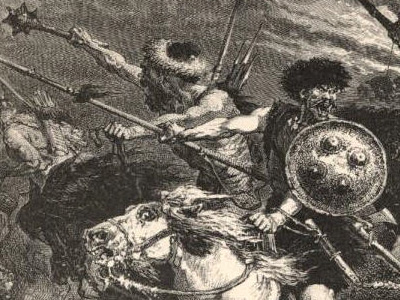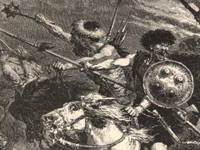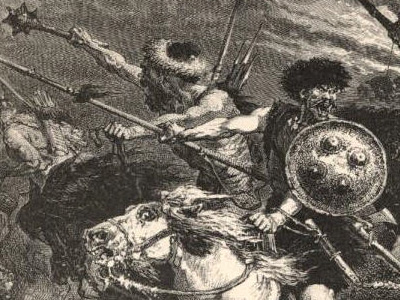Battle of Châlons (451 AD)

Forces
Both armies consisted of combatants from many peoples. Besides the Roman troops and the Visigoths, Jordanes lists Aetius' allies as including the Francii, Riparii, Sauromationes, Aremoriciani, Liticiani, Burgundians, Saxones, and Olibrones (whom he describes as "once Roman soldiers and now the flower of the allied forces"), and "other Celtic or German tribes." Fleuriot argues that the British Litaui also joined Aetius in the battle, being called Liticiani by Jordanes and Britones by Gregory of Tours. Halsall argues that the Rhine Limitanei and the old British field army composed that of the Armoricans, and Heather suggests that the Visigoths may have been able to field about 25,000 men total. Drinkwater adds that a faction of Alamanni may have participated in the battle, possibly on both sides like the Franks and Burgundians.
Jordanes' list for Attila's allies includes the Gepids under their king Ardaric, as well as an army of various Gothic groups led by the brothers Valamir, Theodemir (the father of the later Ostrogothic king Theodoric the Great) and Widimer, scions of the Amali Goths. Sidonius offers a more extensive list of allies: Rugians, Gepids, Geloni, Burgundians, Sciri, Bellonoti, Neuri, Bastarnae, Thuringians, Bructeri, and Franks living along the Neckar River E.A. Thompson expresses his suspicions that some of these names are drawn from literary traditions rather than from the event itself:
The Bastarnae, Bructeri, Geloni and Neuri had disappeared hundreds of years before the time of the Huns, while the Bellonoti had never existed at all: presumably the learned poet was thinking of the Balloniti, a people invented by Valerius Flaccus nearly four centuries earlier.
On the other hand, Thompson believes that the presence of Burgundians on the Hunnic side is credible, noting that a group is documented as remaining east of the Rhine; likewise, he believes that the other peoples Sidonius alone mentions (the Rugians, Scirans and Thuringian) were likely participants in this battle.
Nevertheless, the number of participants for either side is entirely speculative. Jordanes reports the number of dead from this battle as 165,000, excluding the casualties of the Franco-Gepid skirmish previous to the main battle. Hydatius, a historian who lived at the time of Attila's invasion, reports the number of 300,000 dead. However, the Chronicon Paschale, which preserves an extremely abbreviated and garbled fragment of Priscus' account of the campaign, states Attila's forces numbered in the tens of thousands.
The figures both Jordanes and Hydatius offer are implausibly high. Thompson remarks in a footnote, "I doubt that Attila could have fed an army of even 30,000 men." However Lindner argues that by crossing the Carpathians to the area of modern Hungary the Huns had forfeited their best logistic base and grazing grounds, and that the Great Hungarian Plain could only support 15,000 mounted nomads. Kim notes that the Huns continued use of the Xiongnu decimal system, meaning their army was probably organized into divisions of 10, 100, 1000, and 10,000, but no real estimates of Hunnic military capacity can be determined. Their barbarian allies, however, do receive mentions at other times in other sources: in 430 A.D. Octar was defeated by a force of 3000 Neckar Burgundians, and Heather estimates that both the Gepids and the Amali Goths could have fielded 15,000 men each at the Battle of Nedao in 454. Therefore, the total Hunnic forces could have plausibly been in excess of 48,000 men.
Advertisement

These books are available for download with iBooks on your Mac or iOS device, and with iTunes on your computer. Books can be read with iBooks on your Mac or iOS device.

These books are available for download with iBooks on your Mac or iOS device, and with iTunes on your computer. Books can be read with iBooks on your Mac or iOS device.
( Click image to enlarge)
A sense of the size of the actual Roman army may be found in the study of the Notitia Dignitatum by A.H.M. Jones. This document is a list of officials and military units that was last updated in the first decades of the 5th century. The Notitia Dignitatum lists 58 various regular units, and 33 limitanei serving either in the Gallic provinces or on the frontiers nearby; the total of these units, based on Jones analysis, is 34,000 for the regular units and 11,500 for the limitanei, or just under 46,000 all told. However, this figure is an estimate for the years 395-425 A.D. and one that constantly changes with new research. The loss of Africa resulted in the loss of funding for 40,000 infantry and 20,000 cavalry in the Roman army, in addition to previous losses, which was enough to permanently cripple Roman military capacity after 439 AD. While the figure of the Gallic field army cannot be used for the Battle of the Catalaunian Fields, it does indicate the Roman forces present at the battle were significantly lower than the estimated 34,000 men.
The combined forces of the federates would have been far greater in number, while the Roman forces in Gaul had become much smaller by this time. Assuming that the Hunnic forces were roughly the same size as the Roman and federate army, the number involved in battle could be in excess of 100,000 combatants in total. This excludes the inevitable servants and camp followers who usually escape mention in primary sources.
HISTORY

RESOURCES
This article uses material from the Wikipedia article "Battle of the Catalaunian Plains", which is released under the Creative Commons Attribution-Share-Alike License 3.0.
© Stories Preschool. All Rights Reserved.









